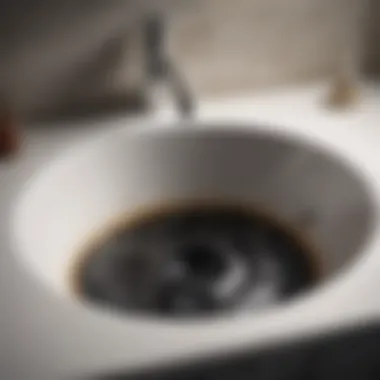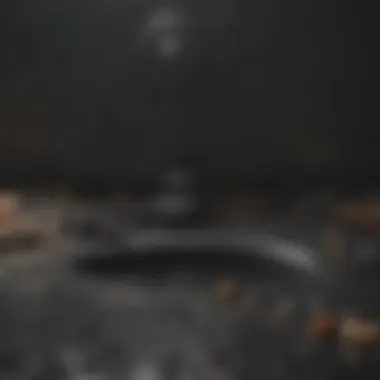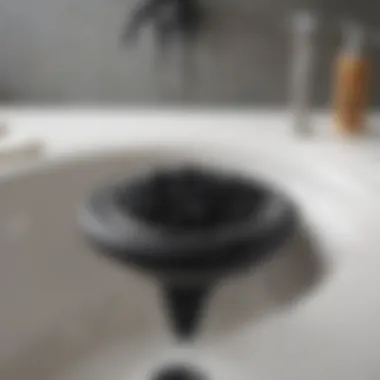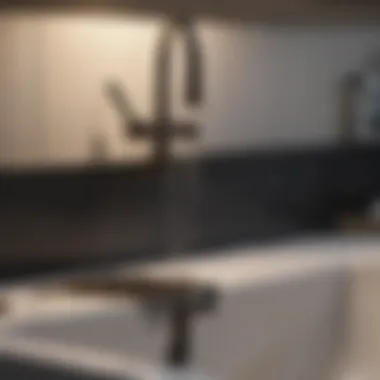Understanding Black Gunk in Bathroom Sink Drains


Intro
Black gunk in bathroom sink drains presents a common yet often overlooked problem. This residue, usually composed of soap scum, hair, and other organic materials, can cause an array of issues if left untreated. The accumulation not only affects the aesthetic of your bathroom but can also lead to unpleasant odors and hinder drainage efficiency.
Understanding the underlying causes is crucial in tackling this issue effectively. This article will provide a thorough overview of the formation of black gunk, its potential health impacts, and practical solutions for prevention and removal. By addressing the problem comprehensively, homeowners and caretakers alike can implement strategies to maintain clean and functional bathroom sinks.
Design Inspirations
While the focus is largely on maintenance, the design of your bathroom plays a significant role in how easily these issues arise. Clever design choices can minimize the risk of black gunk development by promoting easier cleaning and enhancing drainage.
Trending Styles
Consider modern designs that favor smooth surfaces and minimal clutter. Sleek sinks with integrated drainage systems can prevent the accumulation of debris. Another trend is the use of wall-mounted faucets that eliminate the need for complex hardware, thus enabling easier access during cleaning.
Color Palettes
Opting for lighter color palettes can aid in identifying stains and buildup early on, allowing for timely intervention. Utilizing colors that contrast with the typical black gunk—from whites to pastels—can also enhance the overall cleanliness perception in the space.
Maintenance and Upkeep
Regular maintenance is the best defense against black gunk buildup. Adopting systematic practices will prolong your sink's life and maintain hygiene.
Seasonal Maintenance Checklist
- Inspect drains: Check for any slow drainage or odd smells. Prompt identification is crucial.
- Clean sink surfaces: Use appropriate cleaners to remove soap scum and grime regularly.
- Check for leaks: Water leaks can contribute to mold growth, enhancing the black gunk presence.
Cleaning and Organization Tips
- Use drain screens: Prevent hair and larger particles from entering the drain.
- Natural cleaners: Consider using vinegar and baking soda for an eco-friendly solution to remove buildup.
"Prevention is often more effective than treatment when dealing with black gunk in drains."
The importance of regular inspection and cleaning cannot be overstated. By keeping a watchful eye on your bathroom sink and employing effective design principles, you can ensure a cleaner, healthier environment.
Prolusion to Drain Issues
Understanding the challenges associated with bathroom sink drains is fundamental for homeowners and anyone concerned with maintaining a clean and functional space. Black gunk accumulation is not merely a cosmetic issue; it raises important considerations regarding hygiene and longevity of plumbing systems. Neglecting this buildup can lead to more serious issues such as blockages, unpleasant odors, and even potential health risks.
Understanding Drain Accumulation
Drain accumulation refers to the buildup of substances that obstruct the flow of water in plumbing systems. This can happen for several reasons. Everyday activities contribute to the problem. Washing hands and brushing teeth introduce soap, toothpaste, hair, and skin cells into the sink, which initially dissolve in water. However, over time, these materials can agglomerate in the plumbing.
Moreover, moisture and heat in the bathroom facilitate the growth of organic matter. Conditions such as high humidity or erratic temperature shifts can enhance the breakdown of materials, leading to a more pronounced accumulation of black gunk over time. Homeowners should recognize that it is often a slow process, but understanding this gradual build-up is crucial for effective maintenance.
The Commonality of Black Gunk
Black gunk is a widespread issue affecting many households, regardless of the type of plumbing or sink installation. Even well-maintained sinks can fall victim to this problem. While the nature of the black substance can vary, it usually contains bacteria, mold, and inorganic materials like rust or soap residue. Factors such as the level of water hardness and the specific products used for cleaning can influence its appearance and growth.
The omnipresence of this issue means that awareness and recognition of the signs can lead to better preventive measures. Many people might overlook the initial signs. It often appears as an unsightly dark buildup at the drain’s entrance, which can eventually create noticeable slow-draining issues. Ignoring these indications can escalate the problem, making proactive management essential.
"Regularly monitoring and addressing your drain issues provides peace of mind and avoids more substantial repairs or health risks in the future."
Composition of Black Gunk
Understanding the composition of black gunk is essential for homeowners and anyone dealing with bathroom sink issues. The characteristics of this buildup can reveal a lot about its causes and potential solutions. Knowing what this substance comprises helps effective removal and can also aid in preventing future occurrences. The analysis of its components offers insights into how materials combine in drains and the role of environmental factors in their formation.


Organic and Inorganic Components
The black gunk found in drains is typically made up of both organic and inorganic materials. Organic components often include decomposed hair, skin cells, and soap residues, which combine to create a sticky, foul-smelling substance. Additionally, oils and fats from products like lotions or skincare items can contribute to the organic mass. These materials decompose over time and can serve as a breeding ground for bacteria.
On the other hand, inorganic elements often come from mineral buildup, such as limescale from hard water. This mineral content can create a solid base where organic matter can adhere more easily. Therefore, black gunk is a complex amalgamation, demonstrating how various substances can interact in an environment prone to moisture and warmth. Keeping this in mind is crucial for identifying the types of cleaning agents that will be most effective.
Role of Hair and Soap Residue
Hair and soap residue are significant contributors to black gunk accumulation. Hair clumps together, trapping soap scum and other debris, which can hinder water flow in the sink. The interaction between hair and soap creates a sticky texture that clings to pipe surfaces. Once these materials gather in sufficient amounts, they can form a substantial blockage, leading to slow draining or total clogs.
Furthermore, the type of soap used affects how quickly residue forms. Soaps with higher fat content tend to leave more residue, further exacerbating the problem over time. Regular maintenance that focuses on minimizing hair loss and selecting more effective soap options can significantly lessen black gunk formation.
Effects of Humidity and Temperature
Environmental factors such as humidity and temperature also play a crucial role in the formation of black gunk. High humidity levels can increase the moisture in the air, fostering a favorable environment for bacterial growth. Warm temperatures enhance this effect, allowing bacteria to thrive and decompose organic materials at a quicker rate.
The combination of warmth and moisture not only contributes to faster accumulation of black gunk but can also intensify the unpleasant odors often associated with it. Thus, managing humidity levels in bathrooms can be an important step in preventing the buildup of this problematic residue.
Keeping a dry and well-ventilated bathroom significantly reduces the chances of black gunk accumulation.
Health Implications of Drain Buildup
The presence of black gunk in bathroom sink drains is not merely an aesthetic issue. It poses significant potential health risks. Understanding the implications of this buildup can equip homeowners and others with the awareness needed for proactive maintenance. Focusing on this aspect allows individuals to realize the benefits of keeping drains clean and the consequences of neglecting them.
Potential for Bacteria Growth
Black gunk creates an environment conducive to bacterial growth. This environment often includes organic material, such as hair, soap residue, and skin cells, which are nutrients for bacteria. When water stagnates, it amplifies this issue further. Bacteria can multiply rapidly, leading to a higher likelihood of exposure to harmful strains.
People frequently overlook these risks, assuming that the gunk is merely unsightly. However, pathogenic bacteria trapped in these accumulations can lead to infections and other health issues. Regular cleaning and maintenance reduce the chances of creating a breeding ground for such bacteria. Moreover, being aware of the potential for bacterial growth helps reinforce the argument for regular drain upkeep.
Allergenic Reactions and Odors
In addition to bacteria, black gunk can also provoke allergenic reactions. Some individuals may experience skin irritations or respiratory issues linked to mold or mildew that can develop in such an environment. These allergens contribute to poor indoor air quality, potentially making it difficult for sensitive individuals, such as those with asthma or allergies, to breathe comfortably.
Unpleasant odors often accompany the presence of black gunk. These odors result not just from stagnant water but also from the breakdown of organic matter. Such smells can permeate the bathroom space, making it less inviting. Addressing these odors is not only about comfort but also about making a healthier indoor atmosphere. Keeping drains clean can significantly reduce both allergens and odors, contributing positively to overall well-being.
"Maintaining clean drains is integral not only for the functionality of your plumbing but also for your health. A simple routine can prevent significant issues."
In summary, neglecting drain maintenance leads to bacteria growth and allergens. Regular cleaning routines can mitigate these health risks, fostering a healthier environment within the home.
Identifying Drain Problems
Identifying drain problems is a crucial aspect of maintaining bathroom sinks. It helps homeowners recognize issues before they escalate into larger, more complicated situations. When black gunk accumulates in drains, it can lead to functional impairments and unwanted odors. Early detection of these problems allows for timely intervention, thus preserving the efficiency of plumbing systems.
Signs of Black Gunk Accumulation
Detecting signs of black gunk in drains is essential for maintaining a clean and functional bathroom sink. Some common indicators include:
- Slow drainage: Water pools in the sink or takes longer than usual to drain. This is a primary sign that buildup is obstructing flow.
- Strange odors: Foul smells emanating from the drain indicate the presence of organic matter and bacteria.
- Discoloration: Visible stains on drains, often dark or black, hint at accumulated debris.
- Gurgling sounds: If you hear noises as water flows down, this suggests air trapped behind a blockage.
Timely identification of these signs can enable homeowners to take proactive measures.
Differentiating Between Issues
Understanding the difference between various drain issues is important for effectively addressing problems. Many may confuse simple slow drainage with severe clogs.
Clogs vs. Slow Draining


This distinction holds significance when evaluating issues in drains. Clogs refer to severe interruptions in the flow of water. A clog generally results in water not draining at all, frequently causing overflowing sinks. Slow draining, on the other hand, indicates a partial blockage, where water drains but inefficiently. Homeowners must recognize these differences to apply appropriate methods of removal.
A key characteristic of clogs is that they often build up rapidly due to sudden influxes of debris. Slow drains, while persistent and annoying, may arise gradually, often allowing some water to flow away. Strategies for resolving clogs usually involve more intensive measures than those necessary for slow drains, making this distinction quite beneficial when crafting remediation plans.
Persistent Odors vs. Temporary Smells
Odors are another matter where differentiation is helpful. Persistent odors tend to linger, indicating longstanding issues in drains. They frequently stem from the decay of organic materials in black gunk, leading to health risks. In contrast, temporary smells can arise during specific activities, like washing dishes or rinsing products, and may not reflect underlying drainage problems.
A notable characteristic of persistent odors is their tendency to worsen over time. They command attention, demanding immediate action for resolution. On the other hand, temporary smells might disappear shortly after the activity concludes, needing less urgent intervention. This understanding enables homeowners to make informed choices about maintenance and cleaning routines, thus enhancing the overall hygiene level of their bathroom sinks.
"Identifying the correct problem type is essential for choosing the right solution, thus saving time and avoiding unnecessary costs."
Methods for Removal
Removing black gunk from bathroom sink drains is critical not only for the aesthetic appeal of your bathroom but also for preventing potential health hazards. Black gunk can lead to clogs that slow drainage and even cause unpleasant odors. Understanding the most effective methods for removal ensures that you maintain a clean and functional sink, making your home environment more pleasant.
Home Remedies and DIY Solutions
Home remedies offer a practical starting point for dealing with black gunk. Many homeowners prefer these methods because they are often cost-effective and environmentally friendly. Here are some popular home solutions:
- Baking Soda and Vinegar: This classic combination is effective in breaking down buildup. Pour a half cup of baking soda down the drain, followed by a half cup of vinegar. Cover the drain for about 30 minutes, then flush with hot water. This creates a fizzing reaction that can help dislodge gunk.
- Boiling Water: Simply pouring boiling water down the drain can help dissolve grease and soap scum, making it easier to clear out unwanted material.
- Salt and Baking Soda: Mixing half a cup of salt with half a cup of baking soda and pouring it down the drain, followed by hot water, can help break up stubborn clogs.
These methods are useful in day-to-day maintenance. However, they may not always address severe plumbing issues or deep-seated blockages.
Chemical Cleaners: Pros and Cons
Chemical cleaners are another method for dealing with black gunk in drains. They can be quite effective, but they do come with both benefits and drawbacks.
Pros:
- Effective on Tough Clogs: Chemical drain cleaners are often formulated to dissolve tough blockages that home remedies may not affect.
- Quick Action: Many chemical solutions work rapidly, often within minutes.
Cons:
- Environmental Concerns: Many chemical cleaners contain harsh chemicals that can harm the environment and are toxic to pets and children.
- Potential for Pipe Damage: If used too frequently or improperly, these products can damage plumbing pipes, leading to costly repairs.
Consider using chemical cleaners as a last resort for severe blockages after attempting home remedies.
When to Call a Professional
Despite the various methods available for removing black gunk, there are situations where it is advisable to call a professional plumber. Here are some indicators that suggest professional intervention is necessary:
- Persistent Clogs: If multiple attempts at cleaning do not resolve the issue, it could point to more serious plumbing problems.
- Frequent Backups: Repeated issues with slow-draining sinks may indicate that the drain system requires professional inspection.
- Foul Odors: If strange smells continue despite cleaning efforts, it could mean larger blockages that need specialized tools.
It is essential to recognize when a problem surpasses your ability to resolve it. Seeking help from qualified plumbers can prevent further damage and ensure thorough cleaning.
"Understanding the methods for removal is critical for maintaining effective drainage and hygiene in your bathroom."
Preventive Measures
Preventing black gunk buildup in bathroom sink drains is essential for maintaining overall hygiene and functionality. Taking proactive steps can save homeowners time, money, and hassle in the long run. Regular maintenance helps to prevent not only the accumulation of undesirable materials but also potential plumbing issues.
Regular Cleaning Routines
Establishing a regular cleaning routine is one of the most effective ways to keep black gunk at bay. This includes not just cleaning the sink but also the drain itself.


- Schedule frequent cleanings: A weekly cleaning can help eliminate soap scum, hair, and other organic matter that contribute to buildup.
- Use natural cleaners: A mixture of baking soda and vinegar can be particularly effective. Pouring this down the drain offers a thorough clean without harsh chemicals.
- Follow with hot water: After using cleaners, flush the drain with hot water to remove any remaining residue. This also helps to dislodge any materials stuck in the pipes.
Cleaning not only enhances the appearance of the sink but also reduces odors and potential health hazards. Regular attention can lead to a cleaner, healthier bathroom environment.
Using Drain Screens Effectively
Drain screens are a simple yet effective tool that can significantly reduce the amount of debris entering the drain. They act as a barrier, capturing hair, soap, and other particles that contribute to black gunk.
- Choose the right size: Ensure the drain screen fits snugly in or over the drain to capture the maximum amount of debris.
- Clean the screen regularly: It is important to remove and clean the screen at least once a week. Rinsing it under warm water removes accumulated grime.
- Install in all sinks: Consider installing screens in all bathroom sinks, including those with less visible usage, to have a comprehensive preventive strategy.
Using drain screens effectively can dramatically cut down on the amount of gunk that reaches your plumbing, improving the overall health of your sink's drainage system.
Understanding Your Drain System
A fundamental aspect of preventing black gunk accumulation involves understanding how your drain system functions. Knowledge of your plumbing can tailor maintenance efforts effectively.
- Know your pipes: Familiarize yourself with the types of materials your pipes are made of, as they can influence how buildup occurs. For example, older pipes may have more roughness that traps particles.
- Identify problem areas: Be aware of areas in the drain prone to clogging. Sharper bends in the plumbing can hold more debris. Regular monitoring provides insight into potential issues.
- Learn how fixtures operate: Understanding the mechanics of fixtures, like pop-up drains and traps, can highlight where cleaning is most needed.
Being knowledgeable about your drain system encourages targeted preventive measures. This fosters a proactive mindset, making it easier to maintain the health and cleanliness of your bathroom sink.
Environmental Considerations
Understanding the environmental considerations relating to the buildup of black gunk in bathroom sink drains is crucial for both homeowners and the broader community. This section highlights the connection between drain maintenance practices and environmental health, emphasizing how our choices impact not just our immediate surroundings, but also larger ecosystems. The significance of this topic lies in balancing effective cleaning methods with environmental sustainability.
Impact of Chemical Cleaners
Chemical cleaners are often the go-to solution for tackling stubborn black gunk. These products, such as sodium hydroxide and hydrochloric acid, provide quick results but may have detrimental effects on the environment. The harsh components can contaminate water systems, harming aquatic life and disrupting ecosystems. Furthermore, the runoff from our homes can enter local waterways, carrying these chemicals that contribute to pollution.
Some potential drawbacks of chemical cleaners include:
- Toxic Fumes: Many chemical cleaners release fumes that can pose health risks to users and pets.
- Ineffectiveness on Some Materials: Certain blockages, particularly those formed by persistent organic matter, may not respond to these strong chemicals.
- Corrosive Effects: Over time, the reaction with plumbing can lead to corrosion, resulting in costly repairs.
For homeowners, it is beneficial to explore alternatives that ensure cleanliness while adhering to eco-friendly principles.
Sustainable Drain Maintenance Practices
Adopting sustainable drainage maintenance practices can significantly reduce environmental impact. Here are some effective strategies:
- Natural Cleaning Solutions: Instead of chemical cleaners, consider using a mixture of vinegar and baking soda. This combination effectively breaks down buildup without harming the environment.
- Regular Maintenance Routines: A preventive strategy that includes regular cleaning helps prevent severe blockages and reduces the need for harsh treatments.
- Proper Disposal of Waste: Ensure that items like hair, grease, and food particles are disposed of correctly rather than washed down the sink, which helps prevent accumulation.
- Utilizing Drain Screens: These simple tools can capture debris before it becomes problematic, reducing the necessity for chemical interventions.
By implementing these sustainable practices, homeowners contribute positively towards protecting the environment while maintaining functional and clean drains.
"Sustainable practices in drain maintenance not only serve to keep your sink functional but also protect the delicate balance of our ecosystems."
End
The conclusion holds significant weight in this article as it synthesizes the intricate details discussed regarding black gunk in bathroom sink drains. It is vital for homeowners and individuals who engage in regular maintenance of their living spaces. The aim here is to consolidate various insights and recommendations, providing readers with a clear pathway to maintain their drains effectively.
Summary of Best Practices
To prevent the formation of black gunk, several best practices should be observed. These include:
- Regular Cleaning: Establish a routine cleaning schedule. Using a mixture of baking soda and vinegar can aid in breaking down organic matter.
- Drain Screens: Employing drain screens can effectively catch hair and debris before they enter the drain. This simple addition prevents larger accumulations from ever forming.
- Flush with Hot Water: Regularly flushing your drains with hot water can help dissolve soap residue and other materials, ensuring smoother drainage.
Following these methods not only minimizes buildup but also enhances the overall functionality of your bathroom sink.
Future Considerations in Drain Maintenance
As we look ahead, keeping an eye on emerging trends in drain maintenance is critical. Innovative solutions and eco-friendly products are gaining traction, appealing to a more health-conscious audience.
- Natural Cleaners: Explore products that do not rely on harsh chemicals, as these may reduce environmental impact while still being effective.
- Smart Technology: Consider integrating smart technology into your plumbing systems. Smart drains can monitor buildup and alert homeowners when maintenance is necessary.
- Informed Choices: Stay updated about the materials in use in your plumbing systems. Choosing high-quality pipes and fittings can reduce the chances of clogs due to poor material degradation.
In summary, a proactive approach towards drain maintenance will lead to better hygiene, prolonged plumbing life, and less hassle in the long term.







